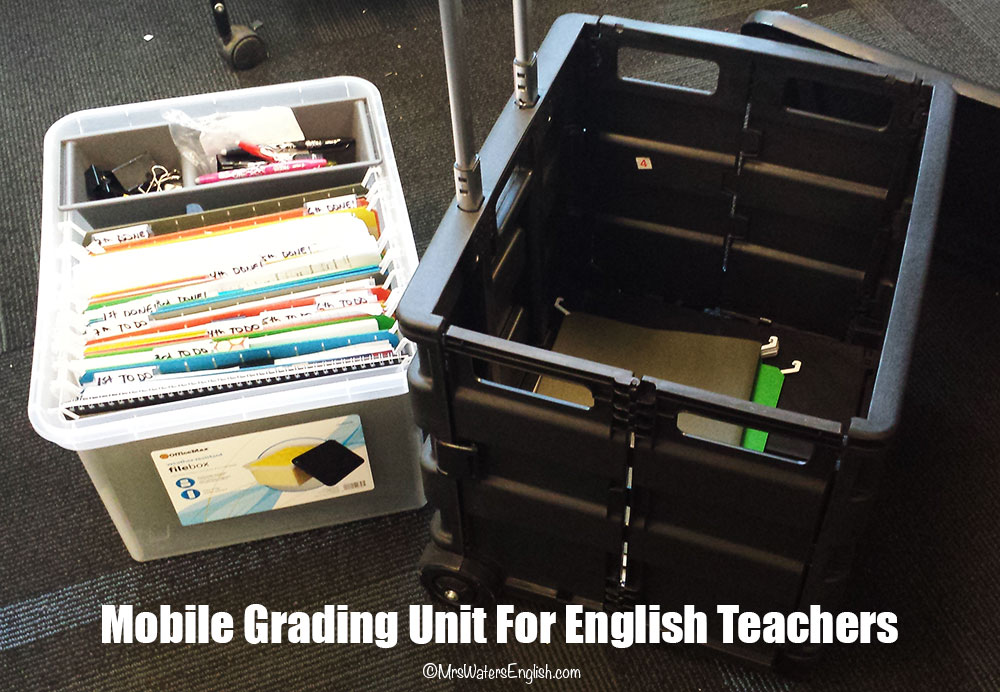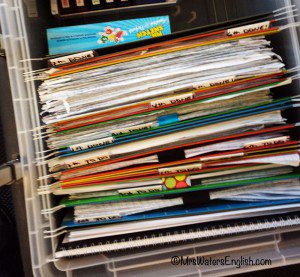If you thought I’d fallen off the face of the earth since a few weeks after school started, you were wrong.
Instead, I have fallen into the English Teacher Paper Grading Abyss. I have not been seen by anyone since mid-September, and my husband is considering reporting me as a missing person. Unfortunately, my actual physical presence, though obscured by the stacks of student papers, precludes accurate reporting.
My children have stood at the edge of the abyss, holding their arms out — and sometimes waving chocolate, which I admit works — in futile attempts to distract me from my mission. Failing that, they have offered to help. Last night, my daughter helped me staple rubrics to the front of student writing packets while we watched a few episodes of Star Trek: Voyager on Netflix.
All that said, once I settle in and start grading with a vengeance, I can plow through my piles of paper in a few hours. The problem at the beginning of the year was getting those papers from school to my house and back again without really losing anything, or getting so disorganized that papers might as well be lost.
Enter the bright idea: A Mobile Grading Unit.
Assembling the unit
After a rather lengthy trip to my local office supply store, where I spent what seemed like an hour on the file storage aisle, I finally had a solution. You can click the images below to see the specifications for what I purchased (via my affiliate link), and purchase those items via Amazon, saving you all the time I wasted in the storage aisle.
Weather-Resistant Plastic File Box
The weather-resistant file box above will enable you to organize as many hanging files as you need safely, even when it’s pouring outside. This file box is 15 inches wide (with a wider “lip” to rest on top of the rolling cart) and 11 inches deep, so it will fit perfectly inside the portable cart I recommend below.
Portable Folding Cart
The file box will fit right down inside the cart, which is 17.5 inches wide and 15.75 inches deep. This allows the box to rest on top, so the lid is easy to remove and replace. Now, if you snoop around the Amazon website, you’ll see a portable file box that already includes hanging files and a lid. If you have fewer than 80 students (I have 140), or if you are a math teacher who doesn’t have to lug home tons of writing assignments (I’m jealous!), then you can get away with this smaller Mobile File Cart.
Hanging File Storage Bin
The beauty of this storage bin is that it helps fill up some of the space in the file box, allows for storage underneath itself, and holds all the pens, stamps and binder/paper clips I carry around to help me manage all the papers.
Organizing the files
I decided to include two hanging files for each class period I have. One hanging file is the TO DO file, in which I keep papers that need to be graded. I also have a DONE folder for each class period, where I house papers that have already been graded. When I return to school, I place all those files in the return bins to await the day I return papers to the students.
When I first setup the unit, I had the TO DO and DONE folders for each class next to each other, but this proved to be a bit confusing, not to mention disheartening when I’d been grading papers for hours, but my file box still looked the same. So, I have moved all the DONE folders to the back of the box. Now, I can see a huge difference when I have made significant progress in my grading: All the DONE folders fill up while the TO DO folders shrink. Whew!
Looking for ways to rethink grading?
Grading shouldn’t take up all your time and you shouldn’t have to spread it out so much that students don’t see the results of their work until weeks later. So what can you do?







Great idea! I have started having my students share their writing to the class. This allows me to grade the paper as they share while providing practice speaking in front of others which is also one of our standards. After two or three periods, every paper is graded, they get faster feedback, and they are able to hear how their peers write. My students who are fearful of speaking in front of others are getting much more confident, and I am not lugging piles of essays back and forth.Of course, there are some that I take home to grade, but this has really helped with the work load at home.
I love your idea, Sunny! When we start writing longer pieces, I’ll definitely incorporate this process.
I also started having the students evaluate their own bell work writing based on a rubric I have taught them. Their bell work is comprised of daily reflective and narrative writing assignments, so far, and by having them do an initial evaluation, I won’t have to spend quite as much time on each paper.
Perhaps I can have them focus on one specific bellwork assignment from the week and present it for grading each Friday. All the other work can be considered a draft, which can be pulled at any time in the future for revision and publication to the class…
Thank you, Sunny!